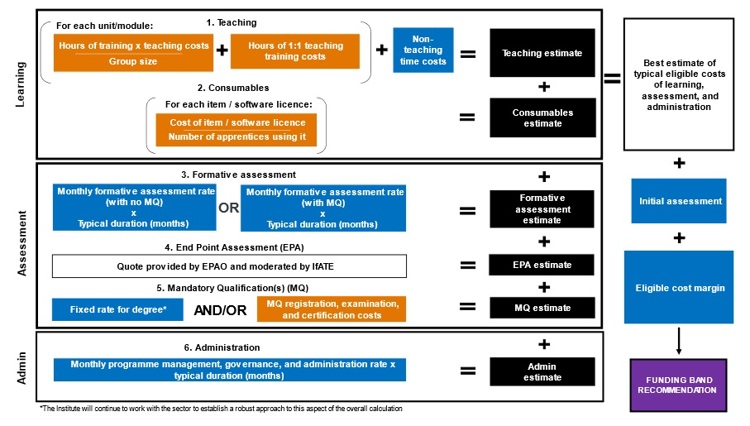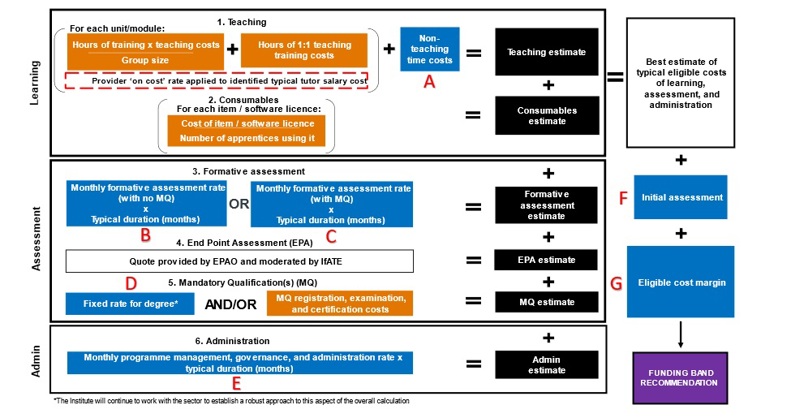funding model - calculation and explanation of rates
Our funding model makes use of several different rates and formulas.
The model is separated into 3 aspects of learning, assessment and administration.
The learning aspect is separated into teaching and consumables costs. The teaching costs are calculated using the tutor salary and the number of hours in group delivery and the number of hours in 1:1 delivery. An uplift is then applied to account for non-contact teaching time. The cost of consumables is calculated using the individual cost of an item, e.g. software licence, and the number of apprentices using the item.
The assessment aspect is separated into formative assessment, end-point assessment and mandatory qualifications. The figure used for the formative assessment rate in the model will depend on whether a mandatory qualification is included in the apprenticeship. If a mandatory qualification is included, then a higher rate is applied. The end-point assessment element relies on the submission of a quote provided by an end-point assessment organisation which is then moderated by IfATE. The mandatory qualification element relies on the submission of a quote provided by the trailblazer. The figure used for the degree rate in the model will depend on whether the apprenticeship is a level 6 or a level 7 degree. If a level 6 degree qualification is included, then a higher rate is applied.
The administration aspect is calculated using a fixed rate multiplied by the monthly duration of the apprenticeship. These costs are combined to create the best estimate of typical eligible costs of learning, assessment and administration. An eligible cost margin is then applied before calculating the funding band recommendation.
Following DfE's recent update to the funding rules, initial assessment is now deemed an eligible cost. The model takes account of this change using a fixed-rate to capture the typical costs associated with initial assessment.


Our funding model makes use of several rates and formulas. These and their origin are set out in the following table. In the table, letter references A to G are used. These relate to the following parts of the process.
Rates Table
| Rate | How is it used | Value | Origin |
|
Non- teaching time costs(‘A’ in schematic) |
Calculated from the sum of synchronous learning (cohort and 1:1 teaching cost estimates) to equate to 20% of the total teaching estimate |
20% |
Median cost of non-contact teaching time reported in Cost of delivering apprenticeship standards research |
|
Formative assessment – no mandatory quals(‘B’ in schematic) |
Multiplied by duration to give an estimate for formative assessment (where standard has no mandatory qualifications |
£22 per month |
Median cost of formative assessment derived from Cost of delivering apprenticeship standards research where no mandatory qualification included |
|
Formative assessment – mandatory qualification(s) included(‘C’ in schematic) |
Multiplied by duration to give an estimate for formative assessment (where standard includes at least one mandatory qualification e.g. mandatory degree qualification) |
£37 per month |
Median cost of formative assessment derived from Cost of delivering apprenticeship standards research where at least one mandatory qualification included |
|
Mandatory qualification estimate (Level 6 Degree) |
Allocated where at least one mandatory level 6 degree qualification included in apprenticeship. The rate |
£2,000 fixed rate |
Median cost generated from publicly available credit reassessment cost data and Cost of delivering apprenticeship standards data |
|
(‘D’ in schematic) |
captures the summative assessment costs of the degree. |
||
|
Mandatory qualification estimate (Level 7 Degree)(‘D’ in schematic |
Allocated where at least one mandatory level 7 degree qualification included in apprenticeship. The rate captures the summative assessment costs of the degree. |
£1,000 fixed rate |
Median cost generated from publicly available credit reassessment cost data and Cost of delivering apprenticeship standards data |
|
Programme governance, management, and administration rate(‘E’ in schematic) |
Multiplied by duration to give estimate for administration costs |
£32 per month |
Median cost of administration reported in Cost of delivering apprenticeship standards research |
|
Initial Assessment(‘F’ in schematic) |
One off addition allocated to all apprenticeship funding band calculations |
£80 fixed rate |
Median cost of initial assessment reported in Cost of delivering apprenticeship standards research |
|
Eligible cost margin(‘G’ in schematic) |
Applied to sum of teaching estimate, formative assessment estimate, and admin estimate |
9% |
Percentage uplift to reflect the need for a commercial organisation to have some level of margin above those costs deemed eligible, derived from ESFA Financial Health Assessment https://www.gov.uk/government/publications/esfa-financial-health-assessment |
|
Provider ‘on-costs’ |
Applied to the identified typical tutor salary cost |
18.05% |
Percentage uplift to contribute towards typical provider National Insurance and pension ‘on-costs’ https://www.gov.uk/national-insurance-rates-letters, https://www.thepensionsregulator.gov.uk/en/employers/managing-a-scheme/contributions-and-funding |
Further explanation of the rates found within the funding model:
Non-Contact Teaching: Applied to teaching costs to account for additional eligible non-contact teaching time costs. This includes an average contribution towards supporting mentoring, supporting self-directed learning, as well as travel and accommodation costs, and includes building rent and room hire that could be wholly attributed to the delivery of the apprenticeship standard in question.
Formative assessment (all assessment that takes place before the end-point assessment, such as tripartite progress reviews): Formative assessment refers to the assessment activities which are essential to indicate the learner’s readiness to pass through the gateway for EPA, where the activities are eligible for funding and are not conducted as part of EPA.
Programme governance, management, and administration: Refers to eligible overheads such as administration linked to training, assessment, and registration, administration linked to Individualised Learner Record, audit paperwork, and composing programme timetables.
Provider ‘on-cost’: Combines the legal minimum employer pension contribution of 3% for their employees with the typical employer National Insurance contribution 15.05%.
Best estimate of typical training delivery salary costs: Combines Office for National Statistics gross salary data with our provider ‘on-costs’ rate. Where our best estimate has been adjusted in line with published criteria for Trailblazer supplied evidence we will calculate the typical salary using a 37 hour working week and a 52 week salaried year. We will use the lowest verified typical training delivery salary cost identified to make this calculation.
ANNEX 2 – ADDITIONAL NOTES
End-point assessment costs
The end-point assessment (EPA) tests the knowledge, skills and behaviours that an apprentice has gained during their training. Unique to each apprenticeship, an EPA demonstrates the competence of an apprentice in their role.
When the EPA plan is available, the trailblazer will source and provide IfATE with quote(s) from end-point assessment organisations (EPAOs). The quote(s) can be obtained from any EPAO that is able to deliver the EPA. We will moderate these to arrive at a more precise estimate of the typical cost of end-point assessment. This moderated estimate will be used when making the funding band recommendation.
In time, we expect to generate an estimate of end-point assessment using a rates-based model.
Initial funding band calculation and early funding information
Up until May 2019, when an occupational proposal was approved, we provided the trailblazer with an ‘initial funding band’. If the trailblazer considered this level of funding to be too low, they could choose to submit quotes from training providers and end point assessment organisations to allow IfATE to generate a funding band.
When we reviewed the initial funding band in early 2019, we found three main issues. First, it was adding very little value to the process of recommending a funding band, as around 95% of trailblazers rejected it. Second, it performed poorly as a predictor of the actual level of funding recommended for an apprenticeship standard, as less than 4% of initial funding bands were within £1,000 of the actual level of funding recommended. Third, trailblazers did not find it helpful to be provided with initial funding bands which they would then routinely reject.
We replaced the initial funding band with ‘early funding information’ in spring 2019. Feedback from the consultation suggests this has been a significant improvement. Trailblazers will continue to receive information on funding levels early in the process of developing an apprenticeship standard, giving them information about the range of funding assigned to similar standards to provide a reference point.
Managing the impact of funding band changes to apprenticeships
When a standard is revised for any reason using the funding model, the funding band may be revised to recognise changes to the content or duration of the standard. Our change request process sets out how this works in detail. Where the model is being used for changes to an apprenticeship, a stability mechanism will apply. It means that funding band recommendations will not be reduced or increased by more than two funding bands. This is to avoid significant funding band changes for apprenticeships that are being revised.
We have a duty to ensure market stability and ensure a value for money approach is taken in making funding band recommendations. The stability mechanism will help ensure we achieve this and has been introduced at the request of the Department for Education to mitigate the risk of significant and sudden changes to funding.
In some cases, it may not be appropriate to apply a stability mechanism. The criteria for exemption from the stability mechanism is set out below:
| Category | Clearly defined category criteria |
|
Where significant structural changes have been made to the published apprenticeship |
|
|
Where an apprenticeship is separated, or two or more apprenticeships are merged |
|
|
Where the published apprenticeship isn’t being delivered because of the funding band |
|
|
Where the funding band was set a long time ago under a very old process |
|
*Very low in relation to expected apprenticeship starts

